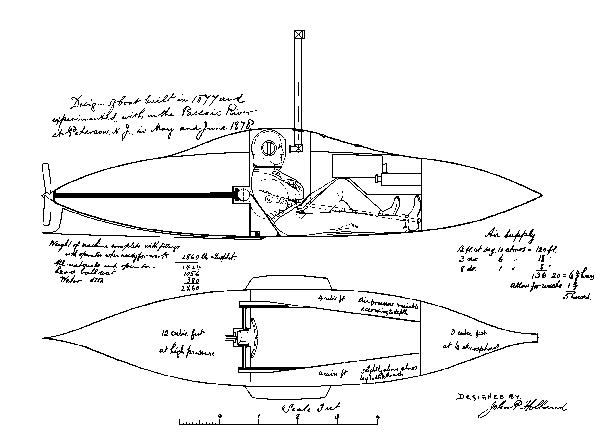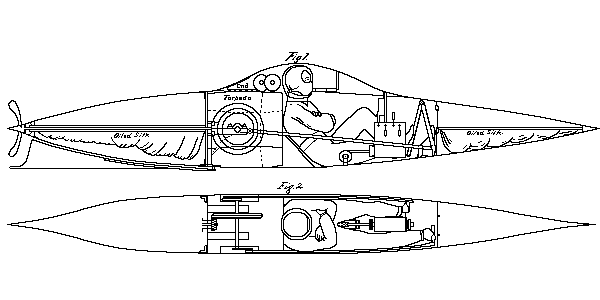

| Length | 12.5 feet |
| Beam | 24 inches |
| Depth | 24 inches |

| Length | 16 feet |
| Beam | 20 inches |
| Depth | 24 inches |
John Holland began sketching submarines as early as 1869 while still living in Ireland. After arriving in the United States in November 1873, Holland slipped on an icy Boston street. He broke his leg and suffered a slight concussion. While recovering, his thoughts turned to submarines. He made a fresh start and was pleased to find his ideas had not changed significantly in four years.1
Two years later, John Holland submitted a design to the Navy Department. John Holland described his first design as follows:
"Boat No.1 had water chambers equal in vol. to the space surrounding the operator, who was to be clad in a diver's suit so that he could, by expending a little compressed air, fill the space around him with water from the chamber and come out of the boat, without changing its buoyancy, or want of buoyancy, and without having to lift the manhole cover against pressure. Another set of chambers were provided so that buoyancy might be destroyed, if desired."
"It was intended that the operator should be provided with one of those diving helmets and connected appts. that afterwards took the form of a knapsack, much as they employed in the Bristol Channel tunnel - I think it was called the Severn Tunnel, so that he could leave his boat on the bottom when it was not too deep, and fasten a torpedo on a ship, or else open the cover and direct and despatch an automobile torpedo - one of the two to be towed after the boat - against the vessel. The operator would close the cover quickly when this was done, and change the water to the outer compartments as quickly as possible to avoid the effect of the concussion from the explosion."
"This was not explained, if I remember rightly, in the specification I sent to Washington during Robeson's reign in Feb, 1875. Comdr. Barber told me the papers are now in the library of the Torpedo Station in Newport. I can remember scarcely anything of what I described, but I know I held a good deal back, and described something I didn't want to do, as I believed they would have no regard to my desire for secrecy. I was right in this point for Commdr. Barber published the drawings and an abstract of the specifications, believing they were patented, or that there was no objection to using them, as they were exposed publicly."
"The vitiated air was separated from the rest, to be pumped out at intervals. The separation was made by a loose diaphragm, so that there might be no difference in pressure."
"The boat described in the specification was not built...."2
”Copyright 1999,2000,2001,2002 Gary McCue